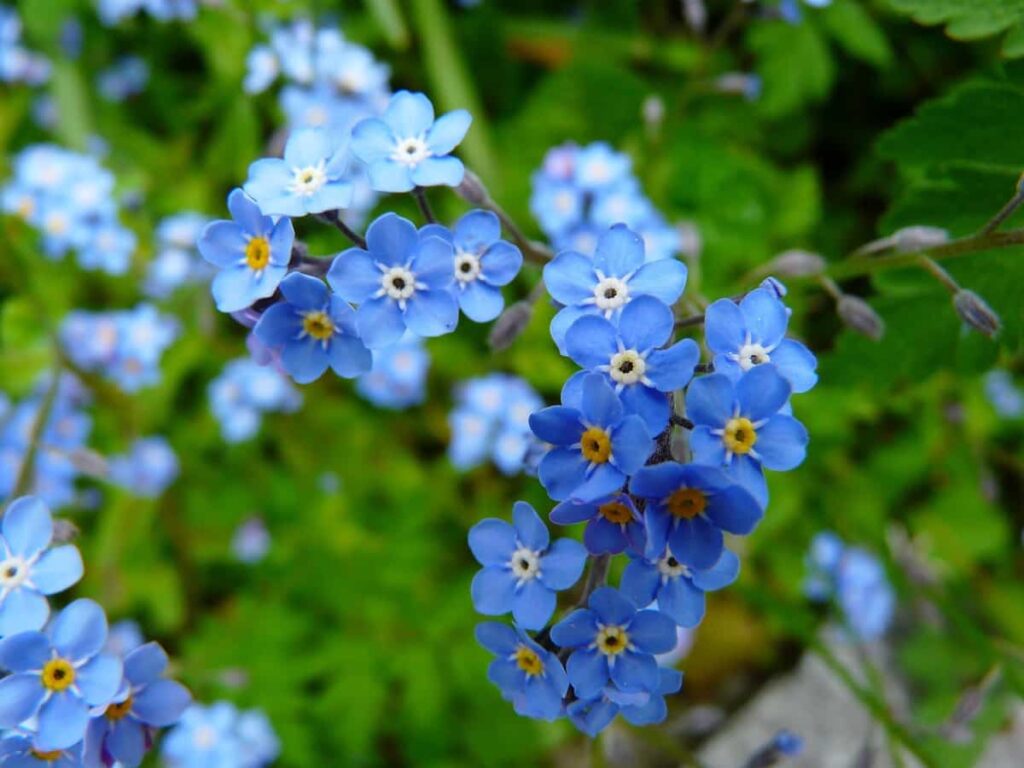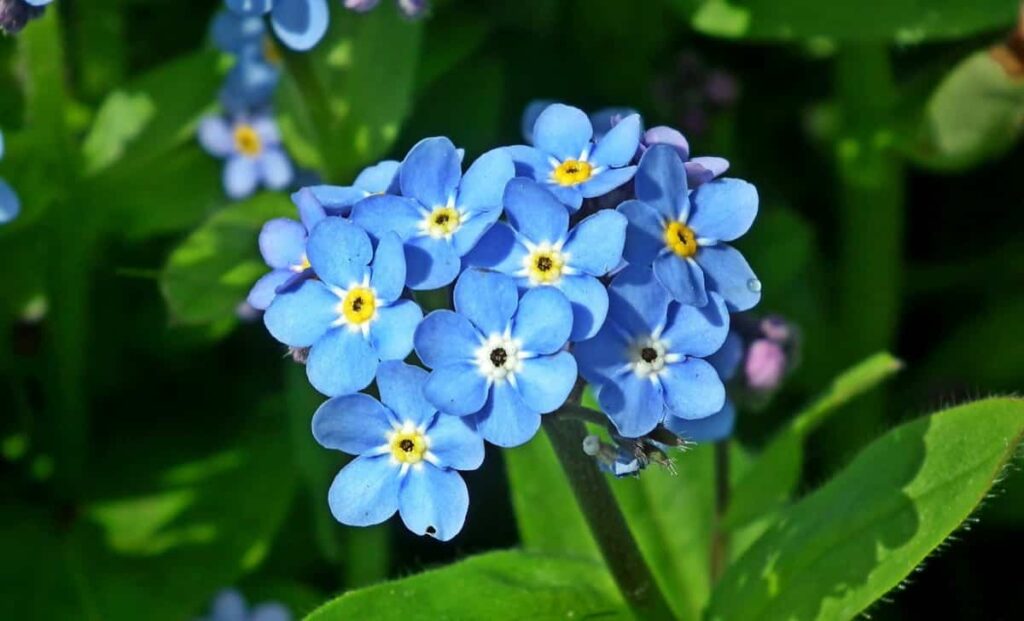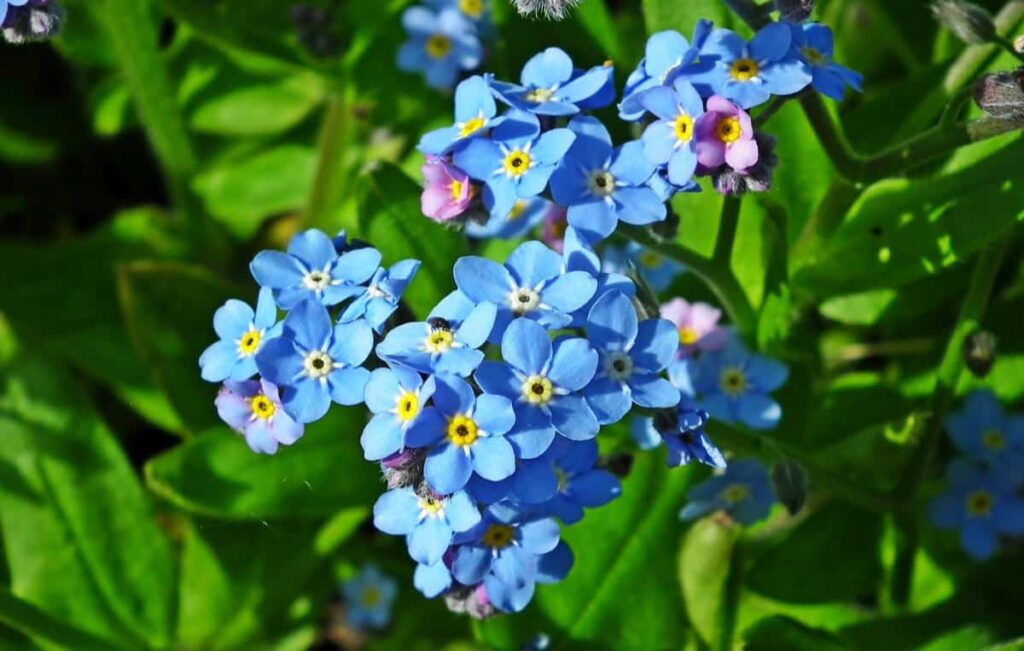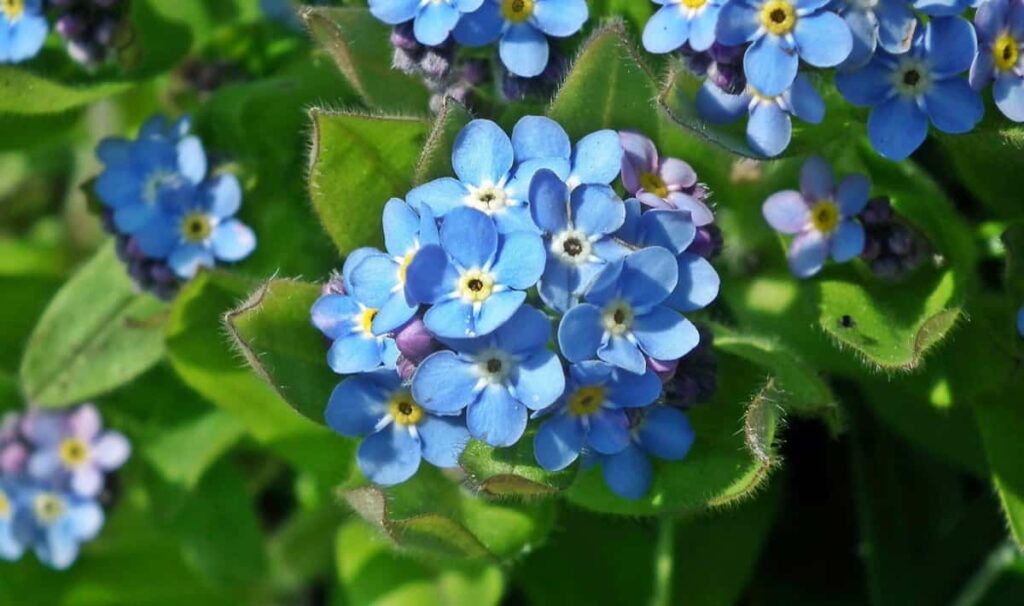The attractive flowers of Forget-Me-Not make it a popular flower. It is common for the blooms to be blue, but there are other colors. Pink buds precede the blooms, which is an additional bonus. It makes a great backdrop for taller tulips or wallflowers, and it naturalizes easily for wilder-style plantings. Window boxes and containers can also be used to display them. Let’s check out more information about growing Forget-Me-Not plants below.

Forget-Me-Not is a short plant with hairy stems, usually less than 5 inches tall when mature. In cymes, the five-petaled flowers are surrounded by additional blooms on branching stems surrounding the central flower. Despite being small (3/8 inch), they provide a good color display due to their large number. Forget-Me-Not is technically a perennial, but most treat it as a biennial, sowing seeds in midsummer and enjoying the flowers the following year. This plant, however, reseeds readily and is considered invasive due to its reseed tendency.
The Forget-Me-Not is a versatile plant. It has rabbit and deer tolerance, attracts butterflies, and can be used in various landscape applications. Plants can be used as ground cover in the yard, potted plants for porches and patios, cottage gardens, woodland gardens, and rock gardens. In areas where you want a carefully controlled garden, you should prevent self-seeding since it spreads independently. Instead, Deadhead any spent blooms and any seed heads that form to prevent them from spreading.
Growing Forget-Me-Not plants
Annual and perennial Forget-Me-Not blooming seasons
One year is required for annual Forget-Me-Nots to complete their life cycle. The small-flowered-Forget-Me-Not germinates in late winter and early spring, blooms in late spring or summer and produces seeds. The plants die back after the seeds disperse. During the winter, the seeds remain dormant and germinate in the spring. Biennials and perennials have specific growing zones depending on low winter temperatures and high summer temperatures, but annuals grow anywhere. Forget-Me-Nots grow during the cool early spring season in hot climates.
Types of Forget-Me-Nots
There are a few main species of Forget-Me-Nots that home gardeners will include in their flower beds:
Woodland Forget-Me-Not
Wildflower gardens and cottage gardens love the woodland Forget-Me-Not. Known as a biennial or perennial, it reaches a height of up to 45cm, making it an ideal ground cover for shrubs and trees with higher growth rates. Furthermore, it can be used as a large individual planting in a flower patch or a meadow. Since the plant’s pH level increases and the petals’ color changes from pale red to blue with increasing development, this is a characteristic trait of the plant.
Their preferred soil type is standard, blooming between mid- and late spring. It can withstand cold conditions, making it a great option for woodland areas. Sow directly outdoors in June or July, with pre-cultivation at the latest in September. Soil should only be lightly covered over the seeds since they need light to germinate. Humus and well-drained soil is therefore required because the plant grows wild in deciduous forests and meadows near forests. It grows well when the soil is moist and the water supply is good.
In case you missed it: How to Grow Mangosteen Fruit from Seed to Harvest: Check How this Guide Helps Beginners

True Forget-Me-Not
Water Forget-Me-Not, also known as True Forget-Me-Not, is an erect rhizomatous perennial with delicate sprays of sky-blue flowers. This epithet is derived from the coiled cymes that resemble scorpion’s tails. Semi-evergreen foliage of shiny, oblong, bright green leaves surrounds the flowers. An attractive flower carpet is formed by this perennial Forget-Me-Not that is easy to grow and resistant to most pests.
Wet areas and water gardens are ideal for this product. In addition, the true Forget-Me-Not is a riparian plant, meaning it grows best near water or in particularly wet soil. Late summer is the time when they bloom. Cold tolerance is lower in true Forget-Me-Nots than in woodland cultivars.
Alpine Forget-Me-Not
Alaska’s state flower, the alpine variety, is native to mountainous alpine regions and is especially suitable for rock gardens. Their blue flowers, which bloom from April through August, provide a splash of color against the rocky backdrop of their natural habitat. Additionally, this cold-tolerant variety blooms in the summer. Alpine Forget-Me-Nots are similar to standard Forget-Me-Nots but prefer different growing conditions and have shorter stalks. The delicate leaves are covered in tiny hairs, adding to the appeal of this flower.
Soil type and preparation for growing Forget-Me-Not plants
When planted in organically enriched soil, abundant water, and partial shade, Forget-Me-Nots are easy to grow. It is best to plant them in moist soil with good drainage in a sunny or shady location. Cool weather and areas with moderate summer temperatures are ideal for Forget-Me-Nots. Forget-Me-Nots can live anywhere between 5.5 and 7.5 pH. If you want to know the exact pH of the soil, you can use a commercial soil pH tester. Because Forget-Me-Nots love moisture, you should start the seeds in an already-wet environment.
The planting bed can be moistened with a watering hose or can, but it will not get soggy. Forget-Me-Not plants should be grown in containers with drainage holes to prevent water from pooling around the roots, which can lead to mold and fungus growth. As Forget-Me-Nots are not very demanding, you can use any light soil mix designed for potted plants. It is also possible to enrich the soil with organic material, such as compost.
Sunlight requirements for healthy growth of Forget-Me-Not plants
Generally speaking, Forget-Me-Nots can tolerate sun to partial shade. You should always check the seed packet or seedling tag information since light requirements will change. Furthermore, consider the relative strength of the summer sun in your region when deciding how carefree the flowers will be.
The weather should be considered if you have a few choices for placing Forget-Me-Nots in your garden. For example, the full sun can be too much for these flowers in a warm Mediterranean climate. In this case, the flowers would benefit from partial shade, especially in the morning when they receive the full sun, and shade during the afternoon when the light is more intense.
In case you missed it: How to Grow Marigold Flowers from Seed to Harvest: A Planting Guide for Beginners

Grow Forget-Me-Not from seed
As evidenced by the plant’s ability to reseed and spread, Forget-Me-Not plants grow easily from seed. This spring bloomer can be introduced into your garden in the following way.
- Buy a seed packet by early summer after choosing the variety that suits your climate.
- Make sure the soil is loose and smooth in a particular garden area by raking it.
- Add soil amendments if necessary, depending on the soil conditions in your garden spot.
- Spread the seeds over the surface in mid-summer and cover them with a thin layer of soil. 2
- Afterward, water the soil lightly and often enough to keep it moist.
- There are two sets of leaves: the seed leaves and the true leaves. Wait until the second set of leaves appears.
- In the yard or planter where you intend to grow the seedlings, transplant them when they are large enough and have healthy roots.
- The seeds will sprout in the fall and bloom the following spring.
Forget-Me-Not plants in containers for indoor conditions
Seeds can also be started indoors eight to ten weeks before the last frost in small pots filled with moistened soilless medium. It is just as possible to grow Forget-Me-Nots in pots as in beds and borders, and there are several reasons to do so. Adding containers with flowers may be a good idea if your garden space is limited. Sprucing up a patio or screened porch with containers filled with Forget-Me-Nots and other flowers is easy. If you wish to enjoy these flowers indoors, you can always grow them in pots.
- Seeds should be sown three to four at a time and lightly pushed into the medium surface.
- Ensure the pots are kept in a dark, warm location, around 18°C to 20°C, and the medium is always kept moist. They take between 14 and 21 days for the seeds to germinate.
- Germination can be encouraged using a heated propagator or a warm windowsill.
- Prevent root rot by setting pots in a water dish instead of watering from above.
- During the second set of true leaves, start hardening off the seedlings. Transplanting can be done either immediately after hardening off or in the fall.
- Transplanted plants will bloom the same year they are transplanted, while those planted in the fall will bloom the following year.
Growing Forget-Me-Not plants from divisions
The seeds or divisions of Myosotis plants can be propagated quite easily. In most cases, garden varieties are biennials and grow from divisions made in the fall and summer. You can divide the surviving Forget-Me-Nots every three to five years after they have flowered in a flower bed.
- First, dig up the root ball and separate it by hand by pulling it apart.
- When transplanting, the hole you dig should be slightly larger than the root ball.
- You will need to loosen the soil at the bottom of the hole before placing the root ball inside.
- Make sure the soil is backfilled up and that it is watered. Before transplantation, the planting spot should be well-drained and moist.
- Afterward, the divisions can be transplanted to other places to grow new flowers.
In case you missed it: How to Start a Terrace Garden from Scratch in Pune/Maharashtra: For Vegetables, Fruits, Flowers, and Herbs

Forget-Me-Not plants care
Watering requirements for Forget-Me-Not plants
Forget-Me-Nots prefer regular watering; water them when the top two to three inches of soil feel dry. Forget-Me-Nots are marsh plants, meaning they thrive in or near very wet soil, so keep them in evenly moist soil and avoid letting them dry out.
How and when fertilizing your Forget-Me-Not plants
Forget-Me-Nots should be fertilized once a year in the spring with a 10-10-10 fertilizer. For every 100 square feet, use two to three pounds. Spread the nutrients into the soil surrounding the plants by spreading the granules and watering afterward. The directions on the package should always be followed. It is suggested to fertilize the plants once or twice a season, once in spring and once in autumn, if necessary. Before they set the seed, pull up the plants if you don’t want them to spread too widely.
Pruning for Forget-Me-Not plants and controlling their growth
Its display value is maximized by massing several plants together and letting them grow as big as possible since the flowers, although pretty, are small. As a result, cutting back Forget-Me-Not stems is discouraged. If you want to prevent reseeding, deadhead the flowers. Forget-Me-Nots are a powerful ground cover that can quickly reseed and spread to other parts of the garden if you don’t control them.
Consider, for example, containing Forget-Me-Nots in a particular area of the landscaping and deadheading blossoms to prevent them from dropping seeds. In addition, you can choose biennial or annual varieties instead of perennials, as they will not grow back each year.
In case you missed it: How to Start a Water Garden: A Step-by-Step Guide for Beginners

Deadheading for Forget-Me-Not plants
Deadheading encourages new growth to encourage more blooms in the Forget-Me-Not plant bed by removing old blooms. The bloom should be pruned back to the first leafed stem when it starts to wilt or fade. In addition to controlling the seeding and spread of your Forget-Me-Nots, allowing some of the flowers to go to seed will allow them to naturally seed the bed for new growth the following year if you want to grow them as annuals.
Common problems for Forget-Me-Not
Powdery Mildew
Powdery mildew is a light-colored, powdery covering on the leaves of plants. Even though it is rarely fatal, it can temporarily ruin the appearance of plants. Conditions that produce high humidity but dry leaves are favorable to this fungus. This pathogen has a close association with the host and is highly specialized. Therefore, a host’s favorable conditions favor the pathogen as well. In addition to mycelium, spores are also present in the white growth. Plants are more likely to have this disease after blooming and during their senescence. Watering overhead should be avoided to minimize it.
Rust
Rust forms pustules on the undersides of leaves, which break open and release orange spores. But you will more likely notice the yellow spots it causes on the top of the foliage. As with powdery mildew, it thrives in moist environments and is best prevented by keeping foliage dry. The infected leaves should be separated from plants and disposed of in mild cases. It is not always necessary to control rust if the plants are infected in the fall. However, plant parts that have been infected should be removed from the soil to prevent the infection of new plants the following spring.
Crown Rot
Crown rot is caused by soilborne Sclerotium delphinii fungi and affects the lower portion of stems near and in the soil. Once crown rot has taken hold, you can only remove and dispose of the entire plant to prevent further spread to neighboring plants because the disease is spread through tools and splashing water. Therefore, it is best to plant your plants in well-draining soil and only water them when necessary to prevent this disease from infecting your plants.
Aphids
Except for the ever-hungry aphid, Forget-Me-Not plants are rarely attacked by insects. As the insects grow or curl leaves, aphids shed white skin, noticeable on your plant if infested with them. It is because they hang out on the undersides of leaves and stems.
How to get Forget-Me-Not to bloom
Although its flowers are only 3/8 inches across, it produces many of them. The blooming period lasts for a few weeks in April and May. Ensure the soil is rich and consistently moist; you will get the longest blooming period and the most flowers. In addition to re-blooming annually with minimal care, Forget-Me-Not is a biennial or short-lived perennial that reseeds.
In case you missed it: How to Grow Broccoli in Pots in India: at Home, on the Terrace, in the Backyard and Balcony

What to do with Forget-Me-Not plants after flowering
Pinch back spent flowers after the Forget-Me-Nots bloom. It is best to pull up or deadhead Forget-Me-Nots before they self-seed to prevent them from spreading. Also, if you have perennial varieties in your garden, cut them down to the ground to clean them up.
Few flowers are easier to grow than Forget-Me-Nots, so they are an ideal bloom for beginners. Water them consistently during the summer months and prune them back if they start to spread profusely and grow rapidly. You should, however, carefully consider these two factors and other planting conditions.
Harvesting Forget-Me-Nots
Forget-Me-Nots are self-propagating, so you don’t need to collect their seeds when you grow them. However, it can be done if you need to harvest seeds for any reason. Spread some newspaper underneath the plants as they begin to turn brown. Pull up the plants and shake the stems over the newspaper until the flower heads drop their shiny black seeds. Place all the seeds you have collected in a container and collect as many as you want.
Conclusion
Home gardeners can grow Forget-Me-Not plants as hardy annuals. Forget-Me-Not plants are low maintenance if you provide them with the right care. Except for the woodland Forget-Me-Not, which grows in shady woodland gardens, these annual flowers grow well in sunny locations. Their stiff stems and dainty flowers make great cut flowers and floral arrangements.
- How to Grow Hibiscus from Flower
- Plantation Ideas for Home Decoration: A Beginners Guide
- Flower Garden Designs and Layouts for Beginners
- Planting and Spacing Techniques in Papaya: A Beginner’s Guide
- Growing Gold: Essential Techniques for Planting Pineapples
- How to Make Kalanchoe Plant Bushy: Home Remedies and Solutions
- 11 Reasons Why Your Gardenia is Not Blooming: Home Remedies and Solutions
- Eco Elegance: The Guide to Designing a Drought-Tolerant Landscape
- Gardening on a Slope: Strategies for Hillside Landscaping
- Nourish and Flourish: Top Organic Mulches for Thriving House Plants
- Everything You Want to Know about Indian Mogra Flower: Discover Uses and Growing
- Green Thumb Success: Expert Tips for Cultivating Greenhouse Pumpkins All Year Round
- Maximize Growth & Flavor: The Ultimate Guide to Companion Planting in Herb Gardens
- How to Control Rhododendron Problems Naturally: Home Remedies and Organic Ways to Fix Them
- Natural Magic: The Remarkable Benefits of Cinnamon for Plants
- Best Steps to Revive Dying Tulip with Natural and Organic Treatment
- 10 Reasons Why Your Angel Trumpet is Not Blooming: Remedies and Treatment
- How to Fix Periwinkle Leaf and Flower-Related Problems: Natural Remedies and Solutions
- How to Fix Zinnias Leaf and Flower Problems: Discover Natural and Home Remedies
- Organic Steps to Induce Lemon Tree Flowers: A Comprehensive Guide
- Bloom Booster: Crafting the Perfect Homemade Bougainvillea Fertilizer
- Optimizing Growth: A Guide to Applying NPK Fertilizer for Potted Plants
- 10 Best Homemade Fertilizers for Rubber Plant: DIY Recipes and Application Method
- How to Boost Female Pumpkin Flowers: Effective Steps for More Flowers and High Yields
- Transform Your Indoor Garden: Top Benefits of Pink Salt for Houseplants
- 10 Best Homemade Fertilizers for Peacock Plants (Calathea): Easy DIY Guide
- Unlock Blooms: 9 Reasons Why Your Potted Chrysanthemum is Not Blooming
- 8 Reasons Why Your Potted Hibiscus is Not Blooming: Fix it with Simple Solutions
- Unlock Blooms: 9 Key Reasons Your Potted Frangipani Won’t Flower
- 10 Reasons Why Is My Ice Plant Not Blooming: Remedies and Treatment
- 10 Reasons Why My Potted Hydrangea Not Blooming: Treatment and Remedies
- 10 Reasons Why is My Wisteria Not Blooming: Remedies and Treatment
- 10 Reasons Why is My Goldfish Plant Not Blooming: Remedies and Treatment
- Maximize Your Space: Ultimate Guide to Balcony Gardening with Grow Bags
- 10 Reasons Why Your Iris is Not Blooming: Remedies and Treatment
- 10 Reasons Why Your Anthurium Plant is Not Blooming: Treatment and Remedies